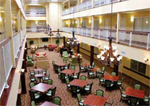
Meeting All the Requirements
Software configuration synchronizes fire and life safety systems
- By Todd Alford
- Jun 01, 2011
Comprising two interconnected threestory
buildings, Silvercreek Premier
Retirement Living overlooks the
Cherokee Valley Golf Course in
Olive Branch, Miss. Silvercreek has
98 luxury apartments and offers catered independent
and assisted living opportunities.
Because it is a retirement facility catering to a senior
community, the design of the fire system posed some
unique challenges for AlarmTec Systems of Memphis,
Tenn., designer and installer of the fire system.
“Seniors are often less mobile, and evacuations can
pose a health risk, so the fire system had to limit unnecessary
impact on the occupants while optimizing
life safety in the case of a fire event,” said Mark Shipp,
owner of AlarmTec.
Specifically, the design called for an intelligent detection
system that could provide appropriate levels
of alarms and notifications, including instructions for
occupants, based on the location and severity of the
fire. For example, if smoke is sensed in only one living
space, it would need to trigger a supervisory signal in
that room only. In living spaces with more than one
room, the sounders would need to be grouped such
that any activated sounder in that living area would
automatically synchronize the activation of the other
sounders.
If smoke is sensed in more than one living
space, each instance would result in a supervisory signal
synchronized across only those rooms in which
smoke is sensed.
In a general alarm, voice messaging
would provide guidance to occupants whenever fire is
sensed in a common space or in the cases of sprinkler
or pull station activation.
Because of the population involved, in order to
avoid a total evacuation, a fire detected in Silvercreek’s
East Building, for example, would result in
speaker activation providing evacuation voice messaging
in that building. Meanwhile, the West Building
would receive a different voice message, putting those
occupants on standby. In this situation, voice messaging
would instruct East Building occupants to evacuate
to the West Building in order to prevent elderly
and disabled occupants from having to go outside unless
absolutely necessary. If conditions warrant evacuation
of both buildings, a voice alarm message would
then direct residents to evacuate to the outside.
Built on three addressable loops tied back to a
NOTIFIER NFS2 3030 panel, one of the biggest
challenges of implementing the fire system was the
requirement to synchronize signals across multiple
rooms in supervisory alarm. To achieve this, AlarmTec
chose to mount intelligent smoke detectors,
in newly available System Sensor B200S addressable
sounder bases, in all the living spaces.
Using the System Sensor synchronization protocol,
these addressable sounder bases now enable installers
to program a command set from the panel,
including selection of volume, tone and grouping, to
tailor the response to specific events. That means synchronization
of the sounders can be achieved using
software at the panel, not physical jumpers or hardwired
interconnections.
“When we first began this project, the addressable
sounder bases were not yet available,” said Rob Duncan,
AlarmTec’s lead project engineer for the Silvercreek
project. The original plan called for the use of
interconnect wiring between sounder bases to group
the signals. However, AlarmTec came in one day to
find that painters had finished all the ceilings, severely
limiting access to the wiring.
“We lost three days trying to find wires and work
through that issue,” Duncan said. “Once we found
out the bases were available, we made a decision to
switch those in and eliminate the use of the interconnect
wires. They mounted to the same junction boxes.
Software configuration only took us two to three minutes
per device from that point, and all of it was done
from the panel. That decision saved us a lot of time
and money.”
In fact, the initial configuration was programmed
to provide a continuous tone in local events. The local
fire marshal asked that a Temporal-3 tone be used for local alarm communications because voice communications would be provided
for general evacuation instructions. In a hardwired system, that would have meant
accessing each device and changing jumper positions, at a minimum.
It also could have meant changing out complete units. Either scenario would
have meant days of labor and disruption to the project schedule. Using the addressable
sounder bases, however, all it took was a simple software
change to modify the command sets, which took less than
10 minutes to accomplish.
This article originally appeared in the June 2011 issue of Security Today.